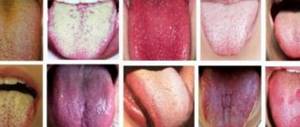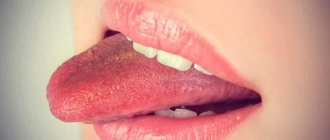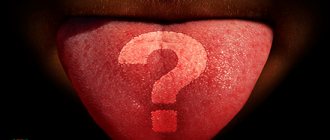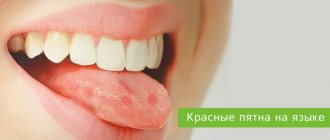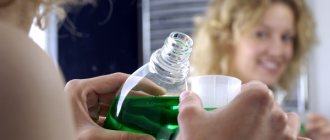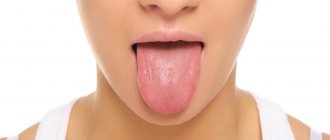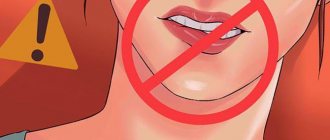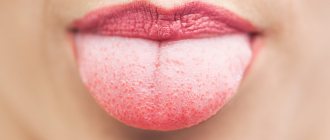The tongue of a healthy person should be matte, pale pink. A slight bloating upon waking, which goes away after eating, is also normal. Sometimes a blue coating is observed and there can be many reasons for this. The most harmless is food coloring added to food.
Also, some types of berries eaten can change color. But the reasons are much more serious, for example, the development of diseases affecting the stomach, liver and other internal organs.
If the tongue gradually darkens even more, then this indicates that the state of health is only getting worse.
Why does the tongue change color?
Normally, the human tongue should be light pink in color with a thin layer of light coating. A change in color indicates that there is some kind of malfunction in the body. Thanks to this ability of the tongue, it has become easier for doctors to diagnose a particular disease.
What can the different colors of the tongue tell us? So:
If the tongue darkens over time, this indicates that the person’s condition is deteriorating. A colorless tongue occurs in those who suffer from vitamin deficiency, anemia, or have an unhealthy diet. Very dark indicates the presence of acute chronic diseases that need to be treated urgently.
The language, or rather its zones, exactly copies the human body. The tip of the tongue is the upper part, and the root is the lower part of the body. Depending on which area of the organ the changes occurred, one can judge the nature of the possible disease:
- the tip of the tongue will tell you about the work of the heart and lungs;
- its horizontal middle - about the condition of the liver, stomach, spleen and pancreas;
- the root of the tongue is responsible for the intestines;
- the sides will tell you about the work of the kidneys;
- the vertical middle corresponds to the spine.
How others can guess your personal traits by the shape of your tongue
Have you ever paid attention to the shape of your tongue? If not, then in vain! The point is that it can be a clear indicator of your core character traits. You may not believe it, but thousands of people confirm the validity of this simple test! Want to test yourself? Then turn to the mirror, examine the shape of your tongue and read the result!
psyforme.com
What to do if your tongue is bluish?
To get rid of the blue color of your tongue, you need to find out why it became that way. To do this, you need to contact the following doctors: gastroenterologist, dentist and therapist. Only after consultation with these specialists, who will conduct a visual examination and collect anamnesis, will you be prescribed appropriate treatment.
If it turns out that you have problems with the digestive system, the doctor will most likely prescribe antibiotics, antispasmodics, and anti-inflammatory drugs. In case of vitamin deficiency, a complex of vitamins will be prescribed and changes will be made to the diet. If the problem arose due to dentures, the dentist will correct them. If the cause of the blue organ is some kind of infection, the doctor will prescribe antibiotics or antifungal drugs.
In addition to treating identified diseases, it is necessary to:
For rinsing, you can also use decoctions and infusions of medicinal herbs:
- chamomile: steam 3 g of dried flowers in 200 ml of boiling water and let it brew for about 40 minutes, then strain and rinse 2 or more times a day;
- calendula: pour 5 g of dried flowers with cold water and put on low heat, after boiling - cool and strain, rinse your mouth after each meal;
- cloves and cinnamon: pour boiling water over 2 g of cinnamon powder (1 stick) and 5 clove buds and let steep for 20 minutes, rinse while warm.
Form C
You have many talents. Whatever you undertake, you do it perfectly. Sometimes a new business doesn’t work out right the first time, but you are not afraid to improve. Your intellectual level allows you to solve complex problems.
You love to learn something new. People around you appreciate your talents, but therefore they strive to communicate with you.
Allow me to sometimes send you the most interesting things on VIBER: I ALLOW
What form of tongue do you have? Did the results of the experiment match what you yourself think about your character? We hope that the information was useful to you!
Source
Therapeutic diet
Regardless of what the cause of the cyanotic organ of taste is, the first thing you need to do is normalize your diet. The following should be excluded from the diet:
You need to eat often, but little by little. Make sure that the intestines are emptied in a timely manner. You need to drink at least two liters of still water per day.
The diet menu should include the following products:
It is better to eat foods boiled, baked in the oven, grilled or steamed. You'll have to give up fried foods for now.
Tongue shape: option A
You feel like you have to please everyone. You often forget about yourself and spend time with other people. You have the following character traits:
• You are a true adventurer; • Always strive to learn something new; • Feel comfortable even in an unfamiliar environment; • They are very touchy and take a long time to get away from quarrels.
You should be careful with your words. That's because the words come out of your mouth faster than you think. This quality will become your number one enemy!
Ways to clean your tongue
To clean your tongue from plaque, a regular toothbrush will do. It can even be without a special rough lining, which is designed to care for the tongue. You can do without it. It is enough to take a medium-hard brush and walk the bristles from the root of the tongue to the lips, using antibacterial paste.
As a device for cleaning the tongue, you can use a scraper specially designed for this purpose. It can be plastic, wood or metal. Some specimens also have special brushes.
Tongue hygiene procedures should be carried out immediately after brushing your teeth. You need to move the scraper from the root of the tongue, gradually moving towards its end. First, the side with the brush is used, and then its hard side is used, with the help of which the tongue is massaged.
If you don’t have a brush or scraper at hand, you can use, for example, a teaspoon, a bandage wrapped around your finger, a clean towel or a textile napkin.
A healthy human tongue should be pink, with a matte tint. A slight morning bloat, which decreases after eating, is also within normal limits. Alarm should be caused by the appearance of heavy plaque, usually resulting from an inflammatory process, or a change in the color of the back of the tongue. Sometimes you can see a blue tongue in a person, the reasons for this may be different. The most harmless of them are culinary or natural dyes; simply by eating some berries you may notice a change in the color of your tongue or lips. However, the cause is not always harmless; most often, a change in the appearance of the tongue is caused by various pathologies, including diseases of the stomach, pancreas, liver, etc.
Everyone can check the state of the language and draw certain conclusions on their own. However, for this it is necessary to know exactly what indicators and factors tell us about certain changes in the state of the body.
Variations in the color of the tongue can be in a very wide range: whitish, brownish, blue, gray, yellowing may be observed. By the way, if a child suddenly has a strange tongue color, you should not immediately raise the alarm. In most of these situations, it turns out that the unusual coloring is caused by something quite ordinary that got into his mouth. These could be felt-tip pens, low-quality drinks, chewing gum, caramels
. In adults, the cause may be recently drunk coffee or excessive smoking.
The next thing you need to pay attention to is the structure of the plaque on the tongue. Knowing what a healthy tongue looks like, you can easily notice the following differences from it:
- Dryness.
- Heterogeneity of plaque.
- Oiliness.
- Looseness.
- Density.
Be sure to set the thickness of the plaque, which is an extremely important parameter. If, during a visual examination, an increase in the degree of plaque formation is noticed, through which the surface of the tongue ceases to be visible, then control over the state of your body must be tightened. If the plaque condition does not improve within 24 hours, it is recommended to visit a doctor and undergo an examination.
Spots may appear on the surface of the tongue, the localization of which makes it possible to determine the location of the source of pathology in the body.
The degree of plaque pain is determined by the ease of its removal. In a healthy person, the layer of plaque is translucent, can be easily removed during morning hygiene, and does not appear during the day. If deposits appear as a result of a malfunction of any organ, then it is almost impossible to remove them completely; moreover, they gradually thicken, acquiring a color characteristic of the underlying pathology.
Normal plaque has a slightly whitish tint, which practically does not affect its transparency. It is easy to remove, has no odor, and the tissues of the tongue are visible through it. In cold weather, slight yellowing may appear.
Is it worth diagnosing by tongue?
Doctors have been studying the question of what diseases can be identified by language for several hundred years. The results of research by ancient and modern scientists show that this connection exists, but it must be properly understood and assessed. If a healthy person has irregularities or the color of the plaque has changed, this phenomenon may be the very first symptom of a disease that will manifest itself in the future with other abnormalities.
There is an assumption that the imprints of the disease appear on this organ several days before its clinical signs, but you should not use diagnosis by a person’s tongue for further self-medication. This is a whole science, and only a good specialist can understand it. Treatment can begin only after a full examination and establishment of a correct diagnosis.
Types of raids
The plaques that occasionally form on the surface of the tongue are very diverse. They differ in color, outline, and localization. Moreover, the color of the tongue and the disease are often directly related. In infectious pathologies, a dense whitish coating is usually observed that covers the entire surface. There is almost always a simultaneous increase in temperature.
If white deposits appear on the middle part of the tongue, and cracks form on the sides, then some pathological lesions of the stomach or intestines can be suspected. Having noticed the first manifestations, it is recommended to change the diet to a more easily digestible one, limiting salt and fat. The appearance of pain indicates the need for emergency examination by a doctor.
White deposits that appear on the front of the organ are evidence of problems with the respiratory system, with the most common cause being tobacco smoking. At the same time, sometimes a person’s speech changes tonality. Developing dysbacteriosis often leads to a fungal infection, manifested in particular by the appearance of whitish spots on the entire surface. Quite often it develops as a result of improper treatment with antibiotics.
An alarming signal is the appearance of a red and white spotted coating. This is what the symptoms of scarlet fever look like. Having noticed such formations, you should immediately seek medical advice; a timely and effective treatment method will allow you to quickly get rid of the pathology without any consequences.
If your tongue turns yellow, you should pay attention to the amount of deposits. A small amount of yellowish plaque should usually not cause concern. However, the intensive formation of a thick layer allows one to suspect the presence of foci of inflammation inside the gallbladder. In this case, you should pay attention to the presence of unpleasant sensations under the ribs on the right side. These are the signs of developing cholecystitis.
A burgundy coating over time turning into a brown crust often indicates food poisoning. If it is small and passes quickly enough, then coloring can occur due to the use of food (natural) dyes, for example, chocolate or coffee. The prolonged presence of such deposits usually indicates dysbacteriosis.
Blue tongue
Some people notice that their tongue has a blue tint. Naturally, this attracts attention and an explanation needs to be found as to why this happens. A blue tongue in a person, if it is not colored by berry juice or other dyes, is a fairly important signal of serious health problems.
Why can the tongue turn blue? This coloration may appear as a result of any serious problem in the functioning of the cardiac system. This most often occurs in heart failure. Cardiopulmonary failure with circulatory problems is especially clearly indicated by the localization of cyanosis on the lower parts of the tongue. In this situation, it is advisable to analyze the general condition, summarize all unpleasant sensations and contact a medical specialist for examination.
If cyanosis appears on the upper plane, then this is almost accurate evidence of the onset of progression of cardiovascular failure, while the remaining symptoms (pain, weakness, feeling of heaviness behind the sternum) may not yet appear. Timely response and implementation of a set of medical measures can often prevent a heart attack.
The tongue may also have a bluish tint. In addition to some disruption of blood circulation, this may reflect the development of the initial stages of scurvy. If a blue plaque suddenly appears in the area located directly in front of the pharynx, then the cause must be sought in a violation of renal activity. Normalization of the functioning of the adrenal glands (proper production of hormones) usually leads to the disappearance of such spots.
Quite rare, but sometimes occurs, a bluish tint appears due to poisoning with heavy metals, for example, mercury. Only a specialist can identify such a lesion after conducting a serious examination.
Form B
You are not afraid to speak the truth to a person's face. No matter how much it hurts, you always strive for honesty. At the same time, you firmly know what you want from life. If circumstances go against you, it makes you angry. You like things to go as planned.
Sometimes you act strange. For example, saying the first thing that comes to mind is not a problem for you. Because of this, people around you often get upset with you, but you don't really want that.
You just can’t hold back the words that are bursting out of you. But despite your excessive frankness, people feel your support. They know that in a difficult situation you will always come to the rescue.
Blue plaque in a child
Every young mother needs to make a daily morning examination of her child’s mouth a mandatory procedure. It should be borne in mind that a small whitish layer, which is easily removed by hygiene procedures or disappears on its own after eating, is the norm. But the appearance of a thick layer or a change in color should cause serious concern.
It is especially necessary to react quickly to a child’s blue tongue. Why should the blue tint of the tongue attract such increased attention? This shade serves as one of the main signals that can reflect the occurrence of a number of pathological problems that begin to progress in the important organs of the child. With such a change in color, problems with the respiratory system, heart (arrhythmias, angina pectoris, etc.), circulatory system, and kidneys can be suspected.
In such a situation, parents are advised to immediately consult a doctor. Young children are not always able to fully describe the sensations that arise, and young parents are not always able to correctly identify what the child is describing. That is why such an important signal should encourage parents to visit a medical facility. Another reason for a blue tongue in a small child may be disorders of the nervous system. With such problems, seizures or cerebrovascular accidents are usually observed simultaneously.
Change in tongue color.
Causes.
Many objects in the world around us change their color at certain points in time. The leaves of green plants change color and inspire artists to paint pictures of the autumn forest. Traffic lights change, ensuring traffic safety. Chameleons change their own colors, which helps them survive. But a tongue that changes color is no fun for anyone. It is perhaps similar to the light of a traffic light and warns of disturbances in the functioning of the body. The appearance of the tongue changes in many diseases, which is used by doctors when making a diagnosis.
Sometimes the tongue turns black, which in this case cannot be called pleasant. Not only is black tongue unattractive, it is also unhealthy. Intensive bacterial growth turns the tongue black. Microbes fill the cracks on the surface of the tongue, giving it a black or dark brown color. Smoking or taking antibiotics can also turn the tongue these colors.
But not only the tongue can turn black, it can turn red, white and even blue. A red tongue is a warning signal. The tongue warns: stop and... Perhaps redness of the tongue is a sign of a disease of the tongue itself (its inflammation) or the so-called geographic tongue, or viral inflammation.
A small amount of light coating that appears daily on the tongue due to bacterial activity and disappears after cleaning is normal. An alarm signal can be given by a suddenly changed color, for example, a blue tongue in a person, the causes of which indicate possible malfunctions in the functioning of some vital organs.
In order to competently organize independent monitoring of the condition of the tongue to identify signs of incipient diseases on its surface, you need to know what factors and indicators you need to focus on.
Blue coating on the tongue - reasons
- The color has a fairly wide range of variations: transparent, white, yellowish, brown, gray. A red, green, crimson, or black tint may also appear. In children, it often turns out that the bright color was caused by a felt-tip pen that was in the mouth. It could be a caramel cockerel, a drink, or chewing gum. Therefore, before you panic, trying to understand why the child has a blue tongue, it is necessary to analyze the diet preceding this event. Adults experience color changes after drinking coffee, and smoking also contributes to this.
- There are several different types of plaque depending on the texture:
- dry;
- homogeneous;
- wet;
- oily;
- dense;
- loose.
- Sediment thickness is one of the key parameters. If upon visual examination it turns out that the plaque has increased in intensity and the pinkish lingual surface is practically not visible through it, control over the condition of the body should be strengthened. If the picture persists for 24 hours, it is advisable to apply for an appointment for examination.
- Localization of a spot of clearly defined deposits on a certain area of the tongue makes it possible to determine the location of the pathological focus in the body.
- The ease of removing plaque shows the degree of its pain. The normal translucent layer is peeled off during morning hygiene measures and does not appear throughout the day. Deposits that appear due to malfunctions in the functioning of specific systems are not completely removed, but after some time they become even thicker and acquire a color tone characteristic of the underlying disease.
The plaque in a healthy person is transparent and whitish in color. It does not block the view of the tissue of the tongue, is easy to clean, and has no odor. May be slightly yellowish in winter.
Interesting
Pigs are more sensitive than people. The person is a fairly average taster. He only has 3 thousand taste analyzers. The whale, which swallows a lot of fish without even chewing, has only a few or none at all. The pig, oddly enough, is more taste-sensitive than humans: it has 5,500 taste analyzers. A cow has 35,000 of them, and an antelope has more than 50,000! So not only do animals have a sense of taste, but many of them are much better tasters than humans. Marine animals are often covered in taste buds on the outside. Fish, for example, sense taste over the entire surface of their body. But creatures such as flies and butterflies can taste with their paws. Snakes and lizards use language for this purpose, but not quite in the same way as we do. They seem to shoot out the tip of their tongue, which catches small particles of food. These particles are delivered using the tongue to a special organ in the upper part of the mouth, which tastes and smells food.
Reasons for the formation of blue plaque
It is advisable to collect and analyze all cause-and-effect manifestations that allow us to solve the problem of why a person’s tongue is blue, in order to notice important signals in time. This shade may appear if there is trouble in the heart area. The localization of this color on the lower surface indicates circulatory disorders aggravated by cardiopulmonary failure.
What to do if a blue coating appears on the tongue
A bluish tint on the tongue appears with scurvy. It may also reflect insufficient blood circulation. For a specialist, this may be evidence of poisoning by mercury or other heavy metals. If a blue coating on the tongue suddenly appears on the edges of the tongue located in front of the pharynx, the reasons lie in the kidney area. This kind of indicator can warn of a serious illness. Blue-black spots disappear only after the functioning of the adrenal glands in producing hormones is normalized.
The bluish upper plane becomes an accurate sign of the onset of the development of cardiovascular failure without the presence of other symptoms such as pain, a feeling of oppressive heaviness, and weakness. This will allow you to carry out a set of preventive measures to prevent a heart attack.
Provoking factors and causes
Various provoking factors cause changes in the color of the mucous membrane and the appearance of layers of plaque on the tongue. These include the following pathogens:
- bacterial microorganisms;
- fungal and viral infections;
- dysbacteriosis of endogenous microflora;
- endogenous and exogenous diseases of visceral organs;
- alcohol abuse, smoking;
- food and toxic poisoning.
In addition to the relationship with pathological changes in internal organs, plaque contributes to the development of secondary infections in the oral cavity and nasopharynx, since it is a breeding ground for anaerobic bacteria.
The reasons why different types of deposits appear lie in the condition of the internal organs and systems. A weakened body is more susceptible to the effects of pathogens and the subsequent appearance of interrelated symptom complexes. There are two main reasons for the formation of plaque in adults:
- tendency to diseases of a bacterial nature;
- damage to individual internal organs.
An additional reason is insufficient oral hygiene. In childhood, the formation of the protein layer is often associated with nutritional principles and hygiene.
Types of plaque that appears on the tongue
The variety of plaques that appear on the lingual surface has its own explanation, based on their characteristic outlines, color shades, and localization.
- The entire tongue is covered with a dense whitish coating with a simultaneous increase in temperature - an infectious disease.
- White deposits appeared in the middle of the tongue with the simultaneous appearance of cracks on the sides - pathological changes in the intestines or stomach. At the first manifestations, it is advisable to follow an easily digestible diet without fatty and salty foods. If you feel pain, you should immediately undergo an examination and obtain medical advice.
- Deposits with a white tint in the anterior area are pathological manifestations in the respiratory system, one of the causes of which may be smoking.
- White spots of deposits all over the tongue are a fungal infection that occurs from the development of dysbacteriosis. Often a consequence of uncontrolled use of antibiotics.
- The presence of a spotted plaque of red and white color is an alarming signal, since the symptoms of scarlet fever often appear. Modern medicine has effective methods for curing this insidious disease; the main thing is to seek help in time.
- The yellowish tint of deposits in small quantities should not cause concern. But with their significant thickness and intensity, we can draw a conclusion about possible inflammatory foci of the gallbladder. If at the same time you begin to worry about pain on the right side under the ribs, you should be examined to diagnose cholecystitis.
- A gray tint of plaque indicates problems in the gastrointestinal system, including increased acidity due to malfunctions that lead to dehydration and disruption of the microflora.
- The transformation of plaque into a brown crust can warn of food poisoning. If there are few deposits, it is worth analyzing the diet to identify products that can color them brownish (chocolate, coffee, cocoa, strong tea). A non-disappearing plaque like this may indicate dysbacteriosis.
The black color of the deposits should alert you, as this may be a sign of the disease entering a critical phase.
Causes of plaque in a child
Daily examination of the internal lining of the oral cavity should become a mandatory procedure. A light thin whitish layer on the tongue that disappears after hygiene procedures or eating is normal. If the whiteness does not disappear during the day, and the layer of plaque thickens, it can be assumed that the baby has a common fungal infection, usually called thrush.
Why is there a blue coating on the tongue?
If this disease is not treated promptly, painful ulcers will develop, which will make the child worry and cry. Whitish rashes also appear during colds, disappearing after recovery. Indigestion and vomiting paralleled by a whitish coating should alert parents and prompt them to immediately obtain a qualified medical opinion, as this could be gastritis.
A child’s blue tongue requires special attention, one of the key indicators that can reflect a number of pathological problems in various important sectors of the body:
- respiratory system;
- heart (angina pectoris, arrhythmia);
- circulatory system;
- kidneys
Babies who cannot yet speak cannot express the discomfort that arises from incipient diseases, and parents do not always know how to correctly identify the child’s crying as a consequence of the pain experienced. Therefore, any signal should serve as the beginning of close observation and, if deviations are detected, immediate contact with doctors. Often, a blue tongue in an infant is associated with disorders of the nervous system, accompanied by convulsions and disruptions in the functioning of the cerebral circulation.
Incredible!
Language helps you see. A revolutionary technology that makes it possible to partially restore vision to blind people using the nerve endings of the tongue was created by American scientists. The theoretical basis for the latest technology was laid back in the 1960s by the famous neurosurgeon Paul Bach y Rita. He suggested that a person sees not with his eyes, but with his brain. In this case, vision serves only as a “delivery” of external light signals. Now these scientific assumptions have been confirmed in practice, when scientists have created a special device that largely restores vision. It consists of glasses that capture light and transmit information to a special miniature device. The latter converts light waves into electrical signals that are sent through a thin cable to the tongue. The tongue was chosen as a channel for transmitting signals to the brain, since its nerve endings are very sensitive and capable of transmitting a large amount of information. Thus, the tongue partially replaces the 2 million optic nerves that lead from the human eyeball to the brain. As it turns out, the impulses received by the tongue are converted into images in the brain. The magazine reports that during the tests, blind people using the latest device were able to see the door, floor call buttons in the elevator, and even letters.
Ways to cleanse your tongue
To clean the surface of the tongue from the plaque that forms, it is not necessary to use complex techniques. Regular, affordable devices will do.
- The toothbrush may not have a special rough lining on the inside, oriented to directly carry out a thorough cleansing of thin normal deposits while simultaneously massaging the tongue. It is enough to walk with medium soft bristles with or without antibacterial paste in the direction from the root to the lips, as well as across the tongue to grab the side surfaces.
- You can purchase a special scraper. It is usually made of plastic, although metal or wood products are also available. Some scrapers are supplemented with special brushes.
If necessary, use reasonably accessible devices, for example, a teaspoon. You can take a bandage, wrap it around your finger, or use a clean towel or textile napkin.
Purely concrete
The mandatory daily ritual of brushing your teeth should also include a tongue cleansing procedure. The heterogeneous microrelief of this organ, consisting of papillae of different sizes, is an ideal field for the proliferation of pathogenic bacteria.
The most plaque accumulates in the morning. Therefore, it is better to carry out this procedure at this time of day. Today there are special tongue brushes made of metal, rubber or plastic on sale. But you can get by with improvised means. A regular teaspoon will do. After dipping it in warm water, you need to gently scrape it across your tongue until there are no traces of plaque left on the spoon. After cleaning, the tongue should be lubricated with olive or any other vegetable oil to prevent irritation. A cleaned tongue looks refreshed and healthier. In addition, after this procedure, the taste of food is revealed in a new way, and all the nuances of the taste of well-known dishes are felt much brighter. The use of a brush is especially necessary:
● in the presence of a large amount of plaque; ● with deep cracks in the tongue; ● when there is bad breath; ● smokers.
Another way to cleanse the tongue is the famous lion pose. With your eyes widened and your mouth wide open, you need to stick your tongue out as far as possible, trying to reach your chin. During the exercise, you need to strongly strain the muscles of the face, neck and chin for 5 seconds. Then you can relax for 15 seconds and then repeat the same pose again. 5-6 repetitions are enough. This exercise relieves inflammation of the tonsils, improves thyroid function and eliminates bad breath.
